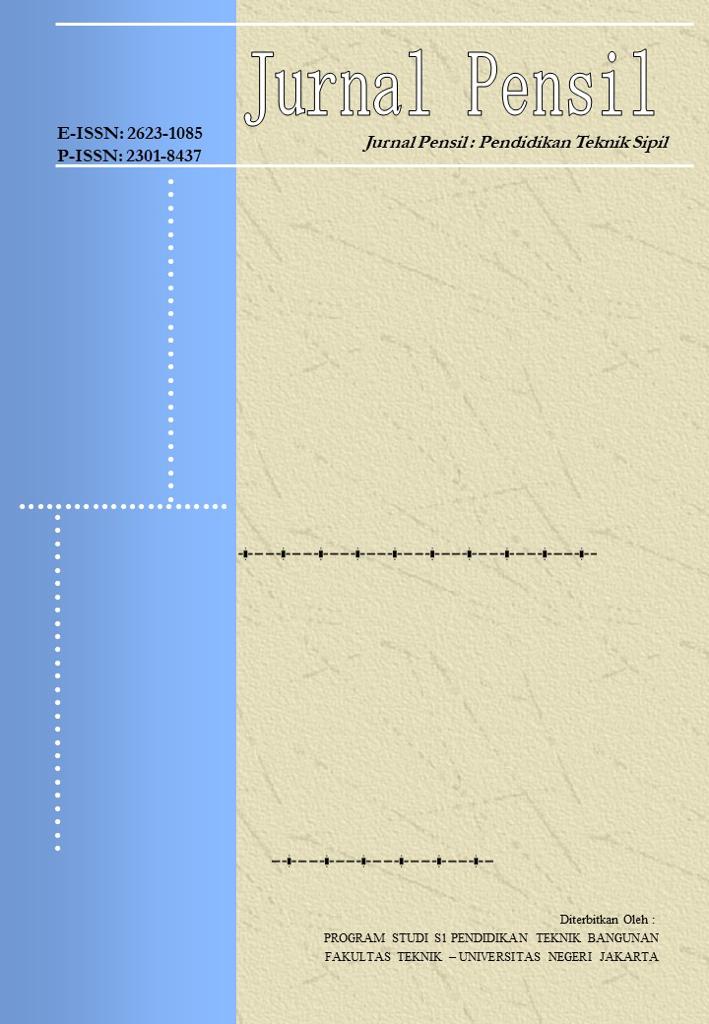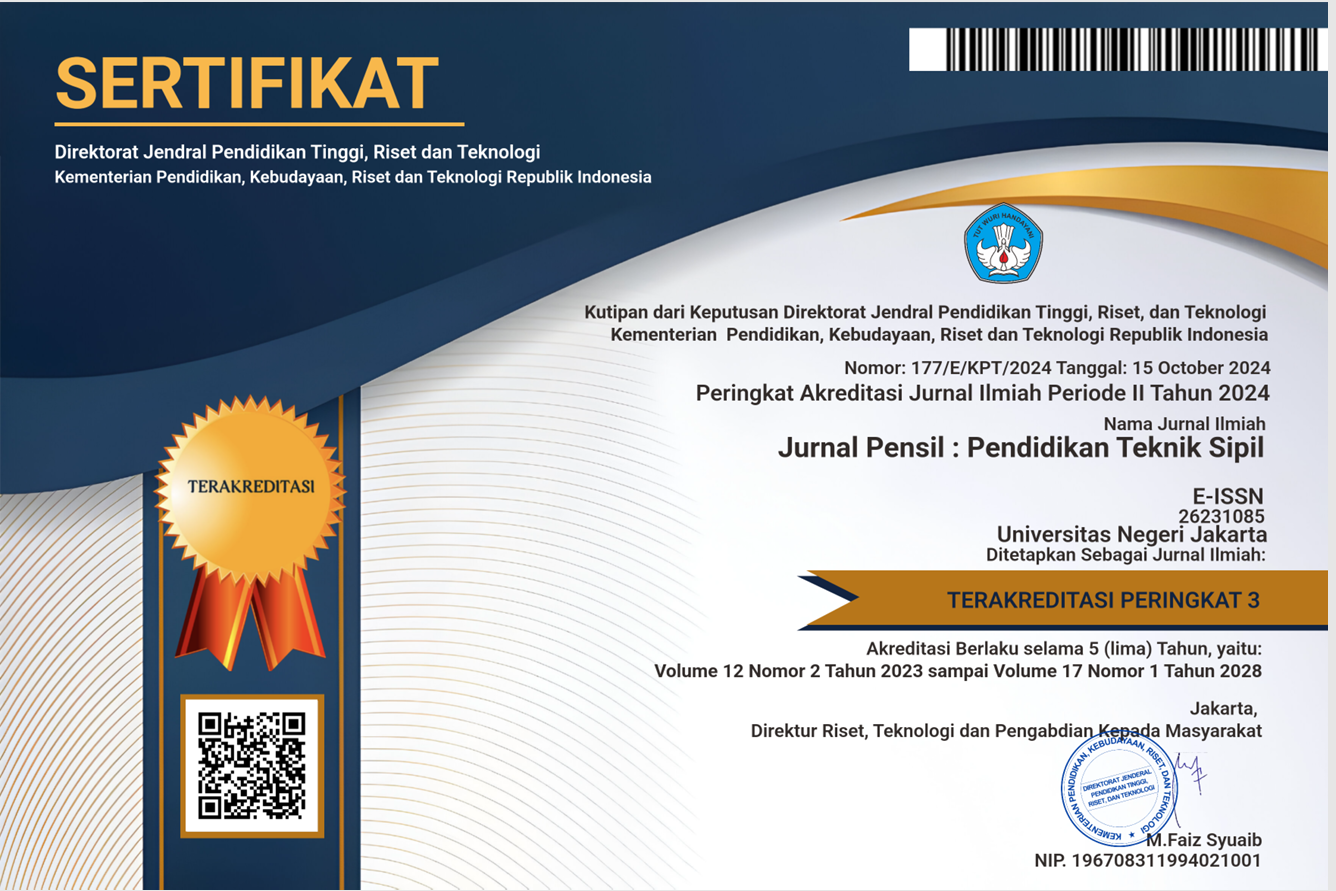FLY ASH AND SILICA FUME SUBSTITUTION ON COMPRESSIVE STRENGTH AND PERMEABILITY OF CONCRETE IN THE MARINE ENVIRONMENT
DOI:
https://doi.org/10.21009/jpensil.v12i3.34971Keywords:
Silica Fume, Fly Ash, Permeability, Compressive StrengthAbstract
Cement, as a concrete-forming material, is a contributor to CO2 emissions in the world. Reducing cement and substituting fly ash and silica fume as concrete substitution materials in the manufacture of concrete makes green concrete without lowering the quality of the concrete. Concrete in the marine environment is frequently destroyed by severe environmental elements, such as seawater penetration; hence, high-performance concrete materials are required. This research aims to analyze the effect of adding fly ash and silica fume on concrete compressive strength and permeability. The specimens made were then immersed in freshwater and seawater. Analysis of the compressive strength test result shows that the compressive strength values for the samples treated with freshwater or seawater have exceeded the expected compressive strength of 30 MPa. The permeability test on the test object resulted in the supplementary fly ash to the concrete immersed in freshwater having a good value, i.e., the water penetration was below that required by DIN-1045, namely 5 cm. The penetration of concrete with fly ash impressed in seawater is good only in concrete with a 10% fly ash variation. The water penetration value still meets the requirements in concrete with silica fume for all variations with freshwater and seawater treatment.
References
Adi, H. P., Wahyudi, S. I., Ni’Am, M. F., & Haji, S. (2020). An Analysis of Plastic Barrels as a Platform Material of Floating Houses in Coastal Areas. IOP Conference Series: Earth and Environmental Science, 498(1). https://doi.org/10.1088/1755-1315/498/1/012066
Al-Lami, M. S. (2021). Correlation between permeability and porosity with other properties of concrete. Journal of Applied Engineering Science, 19(2), 538–546. https://doi.org/10.5937/jaes0-27267
Amudhavalli, N. K., & Mathew, J. (2012). Effect of Silica Fume on Strength and Durability Parameters of Concrete. International Journal of Engineering Sciences & Emerging Technologies, 3(1), 2231–6604. http://www.ijeset.com/media/4N5-IJESET0202520.pdf
Anwar, F. H., El-Hassan, H., Hamouda, M., El-Mir, A., Mohammed, S., & Mo, K. H. (2022). Optimization of Pervious Geopolymer Concrete Using TOPSIS-Based Taguchi Method. Sustainability (Switzerland), 14(14). https://doi.org/10.3390/su14148767
Barbhuiya, S., & Qureshi, M. (2016). Effects of Silica Fume on the Strength and Durability Properties of Concrete. Cesdoc, (December 2016), 117–120.
Basuki, A. (2015). Pengaruh Penambahan Fly Ash Dan Silica Fume Terhadap Daya Tahan Penetrasi Air Beton Normal. Jurnal Teknologi Bahan Dan Barang Teknik, 5(1), 21. https://doi.org/10.37209/jtbbt.v5i1.55
Chaudhary, S. K., & Sinha, A. K. (2020). Effect of silica fume on permeability and microstructure of high strength concrete. Civil Engineering Journal (Iran), 6(9), 1697–1703. https://doi.org/10.28991/cej-2020-03091575
Concrete Centre, T. (2007). The Environmental, Social And Economic Sustainability Credentials Of Concrete.
Davidovits, J. (2008). Geopolymer Chemistry and Applications, 5th edition. In J. Davidovits.–Saint-Quentin, France. Retrieved from https://www.researchgate.net/publication/265076752
Du Preez, A. A., & Alexander, M. G. (2004). A site study of durability indexes for concrete in marine conditions. Materials and Structures/Materiaux et Constructions, 37(267), 146–154. https://doi.org/10.1617/13998
Emmanuel, A. O., Oladipo, F. A., & E., O. O. (2012). Investigation of Salinity Effect on Compressive Strength of Reinforced Concrete. Journal of Sustainable Development, 5(6). https://doi.org/10.5539/jsd.v5n6p74
Gražulytė, J., Vaitkus, A., Šernas, O., & Čygas, D. (2020). Effect of silica fume on high-strength concrete performance. World Congress on Civil, Structural, and Environmental Engineering, (October), 162-1-162–166. https://doi.org/10.11159/icsect20.162
Hannanee Ahmad Zaidi, F., Ahmad, R., Mustafa Al Bakri Abdullah, M., Faheem Mohd Tahir, M., Yahya, Z., Mastura Wan Ibrahim, W., & Syauqi Sauffi, A. (2019). Performance of Geopolymer Concrete when Exposed to Marine Environment. IOP Conference Series: Materials Science and Engineering, 551(1). https://doi.org/10.1088/1757-899X/551/1/012092
Ibrahim, M., & Issa, M. (2016). Evaluation of chloride and water penetration in concrete with cement containing limestone and IPA. Construction and Building Materials, 129, 278–288. https://doi.org/10.1016/j.conbuildmat.2016.10.085
Idrees, M., Akbar, A., Saeed, F., Saleem, H., Hussian, T., & Vatin, N. I. (2022). Improvement in Durability and Mechanical Performance of Concrete Exposed to Aggressive Environments by Using Polymer.
Irawan, R. R. (2013). Semen Portland di Indonesia untuk Aplikasi Beton Kinerja Tinggi. www.pusjatan.pu.go.id
Joel, S. (2020). Compressive strength of concrete using fly ash and rice husk ash: A review. Civil Engineering Journal (Iran), 6(7), 1400–1410. https://doi.org/10.28991/cej-2020-03091556
Kosior-Kazberuk, M., & Lelusz, M. (2007). Strength development of concrete with fly ash addition. Journal of Civil Engineering and Management, 13(2), 115–122. https://doi.org/10.1080/13923730.2007.9636427
Lee, N. P., & Chisholm, D. H. (2005). The durability of RC structures under marine exposure in New Zealand. Science And Technology, 221(18150), 1–31.
Mackechnie, J. R., & Scott, A. C. N. (2012). Durability properties of inorganic polymer concrete using fly ash and slag. Concrete Repair, Rehabilitation, and Retrofitting III - Proceedings of the 3rd International Conference on Concrete Repair, Rehabilitation, and Retrofitting, ICCRRR 2012, 168–174. https://doi.org/10.1201/b12750-27
Manohar, V., & Polu Raju, P. (2017). Comparative study on compressive strength of fly ash concrete. International Journal of Civil Engineering and Technology, 8(4), 1668–1676.
Megahed, S. Y., Elthakeb, A. M., Mohamed, W. A., Nooman, M. T., & Soufy, W. H. (2019). The Impact of Marine Water on Different Types of Coarse Aggregate of Geopolymer Concrete. Journal of Minerals and Materials Characterization and Engineering, 07(05), 330–353. https://doi.org/10.4236/jmmce.2019.75023
Mehta, P. K. (2002). Greening of the Concrete Industry for Sustainable Development. Concrete International, 24(7), 23–28.
Mohammed, T. U., Hamada, H., & Yamaji, T. (2003). Marine Durability of 30-Year-Old Concrete Made with Different Cements. Journal of Advanced Concrete Technology, 1(1), 63–75. https://doi.org/10.3151/jact.1.63
Nath, P., & Sarker, P. (2011). Effect of fly ash on the durability properties of high strength concrete. Procedia Engineering, 14, 1149–1156. https://doi.org/10.1016/j.proeng.2011.07.144
Niveditha, M., & Koniki, S. (2020). Effect of Durability properties on Geopolymer concrete - A Review. E3S Web of Conferences, 184, 1–4. https://doi.org/10.1051/e3sconf/202018401092
Poon, C. S. (1999). Effects Of Fly Ash And Silica Fume On Interfacial Porosity Of Concrete. ASCE Journal, 11(7250), 1–3.
Ramezanianpour, A. (2014). Cement Replacement Materials. In Springer-Geochemistry. https://doi.org/10.1142/9789813238268_0005
Riski, Armynah, B., & G, P. Lo. (2015). The rate of chloride penetration on concrete using rapid migration test. Hasanudin University.
Saker, A., Eltehewy, E., Elsayed, A., & Shaheen, Y. (2008). Water Permeability and Strength of Concrete Containing Silica Fume, Fly Ash, Super Pozz, and High Slag Cement. The International Conference on Civil and Architecture Engineering, 7(7), 648–665. https://doi.org/10.21608/iccae.2008.45499
Salain, I. M. A. K. (2021). Kekuatan dan Permeabilitas Beton Abu Terbang Volume Tinggi. Jurnal Teknik Sipil, 28(2), 133–142. https://doi.org/10.5614/jts.2021.28.2.2
Salain, I. M. A. K., Wirasa, M. N. A., & Pamungkas, I. N. M. M. A. (2020). Kuat Tekan Beton Geopolimer Menggunakan Abu Terbang Jurnal Spektan, 8(1), 105–114.
Shahrabadi, H., Sayareh, S., & Sarkardeh, H. (2017). Effect of Natural Zeolite-Pozzolan on Compressive Strength of Oil-Polluted Concrete Marine Structures. Civil Engineering Journal, 2(12), 623. https://doi.org/10.28991/cej-030985
Skutnik, Z., Sobolewski, M., & Koda, E. (2020). An experimental assessment of the water permeability of concrete with a superplasticizer and admixtures. Materials, 13(24), 1–16. https://doi.org/10.3390/ma13245624
Srivastava, V., Kumar, R., Agarwal, V. C., & Mehta, P. K. (2014). Effect of Silica Fume on Workability and Compressive Strength of OPC Concrete. Journal of Environmental Nanotechnology, 3(3), 32–35. https://doi.org/10.13074/jent.2014.09.143086
Sudarsono, I., Wahyudi, S. I., Adi, H. P., & Ikval, M. D. (2022). Effect of Zeolite on the Compressive Strength of Concrete with Different Types of Cement. IOP Conference Series: Earth and Environmental Science, 955(1). https://doi.org/10.1088/1755-1315/955/1/012002
Suhendro, B. (2014). Toward green concrete for a better sustainable environment. Procedia Engineering, 95(Scescm), 305–320. https://doi.org/10.1016/j.proeng.2014.12.190
Tarru, R. O. (2018). Studi Penggunaan Silica Fume Sebagai Bahan Pengisi (Filler) Pada Campuran Beton. Journal Dynamic Saint, 3(1), 472–485. https://doi.org/10.47178/dynamicsaint.v3i1.271
Wang, L., Zhou, S., Shi, Y., Huang, Y., Zhao, F., Huo, T., & Tang, S. (2022). The Influence of Fly Ash Dosages on the Permeability, Pore Structure and Fractal Features of Face Slab Concrete. Fractal and Fractional, 6(9). https://doi.org/10.3390/fractalfract6090476
Wedhanto, S. (2017). Pengaruh air laut terhadap kekuatan tekan beton yang terbuat dari berbagai merk semen yang ada di kota malang. Jurnal Bangunan, 22(2), 21–30.
Zhang, S. P., & Zong, L. (2014). Evaluation of the relationship between water absorption and durability of concrete materials. Advances in Materials Science and Engineering, 2014. https://doi.org/10.1155/2014/650373











.png)
.png)
1.png)

